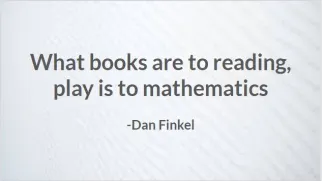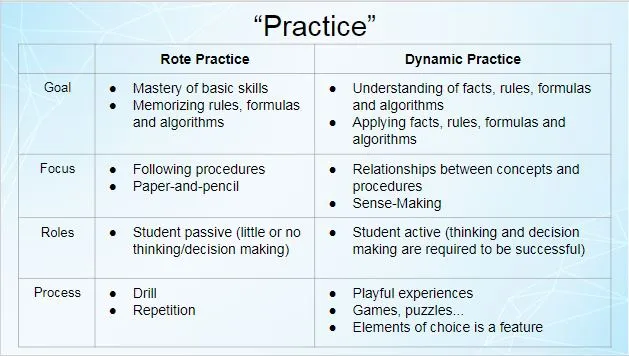A few weeks ago a NYTimes published an article titled, Make Your Daughter Practice Math. She’ll Thank You Later, an opinion piece that, basically, asserts that girls would benefit from “extra required practice”. I took a few minutes to look through the comments (which there are over 600) and noticed a polarizing set of personal comments related to what has worked or hasn’t worked for each person, or their own children. Some sharing how practicing was an essential component for making them/their kids successful at mathematics, and others discussing stories related to frustration, humiliation and the need for children to enjoy and be interested in the subject.
Instead of picking apart the article and sharing the various issues I have with it (like the notion of “extra practice” should be given based on gender), or simply stating my own opinions, I think it would be far more productive to consider why practice might be important and specifically consider some key elements of what might make practice beneficial to more students.
To many, the term “practice” brings about childhood memories of completing pages of repeated random questions, or drills sheets where the same algorithm is used over and over again. Students who successfully completed the first few questions typically had no issues completing each and every question. For those who were successful, the belief is that the repetition helped. For those who were less successful, the belief is that repeating an algorithm that didn’t make sense in the first place wasn’t helpful… even if they can get an answer, they might still not understand (*Defining 2 opposing definitions of “understanding” here).
“Practice” for both of the views above is often thought of as rote tasks that are devoid of thinking, choices or sense making. Before I share with you an alternative view of practice, I’d like to first consider how we have tackled “practice” for students who are developing as readers.
If we were to consider reading instruction for a moment, everyone would agree that it would be important to practice reading, however, most of us wouldn’t have thoughts of reading pages of random words on a page, we would likely think about picture books. Books offer many important factors for young readers. Pictures might help give clues to difficult words, the storyline offers interest and motivation to continue, and the messages within the book might bring about rich discussions related to the purpose of the book. This kind of practice is both encourages students to continue reading, and helps them continue to get better at the same time. However, this is very different from what we view as math “practice”.
In Dan Finkel’s Ted Talk (Five Principles of Extraordinary Math Teaching) he has attempted to help teachers and parents see the equivalent kind of practice for mathematics:

Below is a chart explaining the role of practice as it relates to what Dan Finkel calls play:

Take a look at the “Process” row for a moment. Here you can see the difference between a repetitive drill kind of practice and the “playful experiences” kind of practice Dan had called for. Let’s take a quick example of how practice can be playful.
Students learning to add 2-digit numbers were asked to “practice” their understanding of addition by playing a game called “How Close to 100?”. The rules:
- Roll 2 dice to create a 2-digit number (your choice of 41 or 14)
- Use base-10 materials as appropriate
- Try to get as close to 100 as possible
- 4th role you are allowed eliminating any 1 number IF you want

What choice would you make??? Some students might want to keep all 4 roles and use the 14 to get close to 100, while other students might take the 41 and try to eliminate one of the roles to see if they can get closer.
When practice involves active thinking and reasoning, our students get the practice they need and the motivation to sustain learning! When practice allows students to gain a deeper understanding (in this case the visual of the base-10 materials) or make connections between concepts, our students are doing more than passive rule following – they are engaging in thinking mathematically!
In the end, we need to take greater care in making sure that the experiences we provide our students are aimed at the 5 strands shown below:

You might also be interested in thinking about how we might practice Geometrical terms/properties, or spatial reasoning, or exponents, or Bisectors…
So I will leave you with some final thoughts:
- What does “practice” look like in your classroom? Does it involve thinking or decisions? Would it be more engaging for your students to make practice involve more thinking?
- How does this topic relate to the topic of “engagement”? Is engagement about making tasks more fun or about making tasks require more thought? Which view of engagement do you and your students subscribe to?
- What does practice look like for your students outside of school? Is there a place for practice at home?
- Which of the 5 strands (shown above) are regularly present in your “practice” activities? Are there strands you would like to make sure are embedded more regularly?
I’d love to continue the conversation about “practicing” mathematics. Leave a comment here or on Twitter @MarkChubb3



